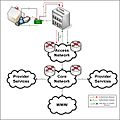Access network facts for kids
An access network is the part of a telecommunications network that connects people and their devices to their immediate service provider. Think of it as the "last mile" that brings internet, phone, and TV services right to your home, school, or office. It's how your computer, phone, or tablet talks to the rest of the world through your internet company.
Contents
What is an Access Network?
An access network is like the road or path that links you directly to your internet or phone company. Without it, you wouldn't be able to send messages, watch videos online, or even make a phone call. It's the local connection that makes sure your data can travel to and from the bigger, global internet.
How Does Your Internet Reach You?
When you go online, your computer or phone sends information. This information first travels through your access network. This network could use different technologies to reach you:
- Wired connections: These use physical cables like copper wires (for older phone lines and some internet) or fiber optic cables (for very fast internet).
- Wireless connections: These use radio waves, like Wi-Fi in your home or the mobile network your smartphone uses.
Connecting to Your Service Provider
The main job of an access network is to connect you, the user, to your internet or phone company. This company is called your "service provider." The access network acts as the bridge between your devices and the provider's main network. Once your data reaches the service provider's network, it can then travel across the world.
Types of Access Networks
There are many different ways access networks are built. The type of network often depends on where you live and what kind of service you need.
Wired Access Networks
Wired networks use physical cables to carry information. They are often used for homes and businesses.
- Digital Subscriber Line (DSL): This uses regular copper telephone lines to send internet data. It's an older technology but still used in many places.
- Cable Internet: This uses the same coaxial cables that deliver cable television. It can offer faster speeds than DSL.
- Fiber-to-the-Home (FTTH) or Fiber-to-the-Premises (FTTP): This is one of the newest and fastest types. It uses tiny glass fibers to send data using light signals. Fiber optic cables can carry a lot of information very quickly.
Wireless Access Networks
Wireless networks don't need physical cables to connect your device to the network.
- Mobile Networks (4G, 5G): These are the networks your smartphone uses to connect to the internet when you're not on Wi-Fi. They use radio towers to send and receive signals.
- Wi-Fi: While Wi-Fi is often used inside your home to connect devices to your router, that router is then connected to a wired access network that goes to your service provider.
- Satellite Internet: This uses satellites orbiting Earth to provide internet access, especially in rural areas where other types of networks are not available.
Why Are Access Networks Important?
Access networks are essential for our modern lives. They allow us to:
- Communicate: Make phone calls, send text messages, and video chat with friends and family.
- Learn: Access online schools, research topics, and watch educational videos.
- Be Entertained: Stream movies, play online games, and listen to music.
- Work: Connect to offices, attend virtual meetings, and share documents.
Without these networks, our digital world wouldn't exist as we know it. They are the vital links that bring the internet and communication services right to our fingertips.
Images for kids
See also
 In Spanish: Red de acceso para niños
In Spanish: Red de acceso para niños


